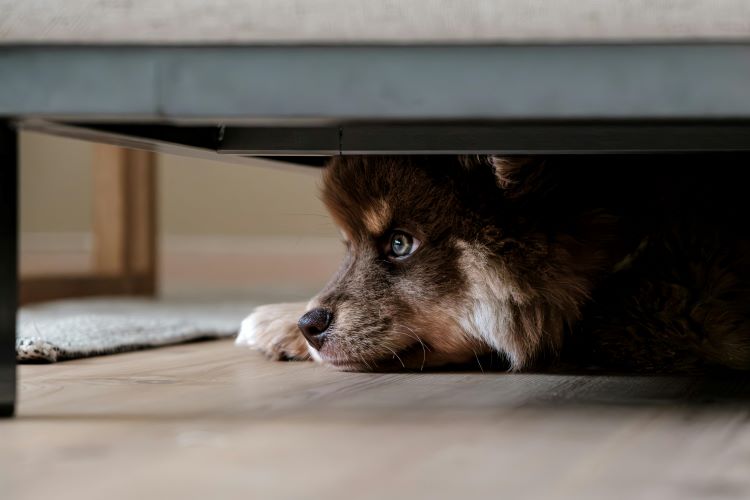Ready to help treat your pet to a healthy life?
Signs of Stress & Anxiety in Dogs: What to Look For
By : Nikki Edwards | Published Apr 29, 2025

Dogs, like humans, experience stress and anxiety that can negatively affect their health. But unlike us, dogs can't verbalize their feelings or seek help. As responsible pet parents, it's therefore crucial to recognize the signs of stress and anxiety in our canine companions to provide timely intervention and support.
Unsure of what stress in dogs looks like? You’re not alone. Many canine behaviors are commonly misunderstood and viewed as just “dogs being dogs” rather than indicators that something is wrong. So, we’ve put together this guide to common indicators your dog might be struggling with stress or anxiety, along with how these signs typically manifest.
Understanding canine stress and anxiety
Before diving into specific signs, it's important to understand that dogs can experience both acute stress (temporary responses to specific triggers) and chronic anxiety (ongoing emotional distress). Though similar, these are two different states with varying levels of severity.
As a temporary state, acute stress can be intense but only momentarily. Once the stressful trigger is removed, your dog is likely to calm down and go back to their happy self. Nevertheless, repeated acute stress can lead to chronic anxiety, so it’s still important to act quickly.
Chronic anxiety is ongoing stress that can lead to serious health issues for your pet. It’s the result of a permanent or long-term stress trigger, like moving homes, being separated from their favorite person, a major construction project nearby, or even the introduction of a new pet in the family. Intervention is needed to help your dog adapt and maintain a sense of calm.
Health and behavioral issues from untreated stress
Keep in mind that, just like you, your dog isn’t likely to be happy all the time and can experience fluctuations in mental state. While occasional stress is normal, persistent anxiety requires attention and often professional intervention. It’s also worth noting that some medical conditions can cause stress and anxiety in dogs, so it’s always important to find the source of the problem.
Health issues caused (and often worsened) by untreated stress and anxiety in dogs can vary. Common conditions include depression, gastrointestinal issues, a weakened immune system, and other systemic illnesses. Anxiety has also been shown to increase the risk of heart disease.
And it’s not just about health. Dogs feeling stressed out can act out aggressively, especially if they are feeling threatened by external stressors. Quick intervention is needed to keep your dog and everyone around them safe.

10 signs of stress and anxiety in dogs
Indicators of stress and anxiety can vary from pet to pet, but there are some common signs to watch for. A Finnish study even found that dogs will exhibit a different range of behaviors depending on the situation stressing them out. So, it’s a good idea to become aware of all of the main indicators of canine stress.
If you suspect your dog is suffering from chronic anxiety or frequent bouts of acute stress, talk with their veterinarian.
1. Changes in body language
A dog's body language speaks volumes about their emotional state. Stressed or anxious dogs often display subtle changes that indicate discomfort:
- Tucked tail — A tail tucked between the legs is one of the most recognizable signs of fear, nervousness, or anxiety.
- Pinned-back ears — Ears flattened against the head often indicate stress but may also indicate aggression.
- Whale eye — Also called a “half moon eye,” this is when dogs show the whites of their eyes.
- Stiff posture — Overall body tension, sometimes freezing in place, can make your pup appear stiff.
- Lowered body stance — A stressed and threatened dog may crouch to appear smaller.
- Raised hackles — The fur along the back and neck (this is known as your dog’s “hackles”) standing up on end is a sign of stress.
These body language cues often appear in combination and may precede other stress behaviors. They represent your dog's first line of communication that something isn't right in their environment.
2. Excessive barking or vocalization
While barking is normal dog behavior, excessive vocalization often signals distress:
- Persistent barking — Barking that continues without obvious external triggers
- Howling or whining — Particularly when left alone or in unfamiliar situations
- Low growling — Not directed at specific threats but as general anxiety expression
This vocalization may intensify during stressful events like thunderstorms, fireworks, or when experiencing separation anxiety. The pitch and rhythm of anxiety-based barking often differs from alert or playful barking — it typically sounds more frantic or desperate.
3. Destructive behavior
Anxious dogs frequently engage in destructive behaviors as coping mechanisms:
- Chewing furniture — Particularly focusing on door frames, window sills, or escape routes
- Digging — Creating holes in yards, carpets, or bedding
- Destroying household items — Often targeting parent-scented objects when experiencing separation anxiety (hello, throw pillows!)
- Scratching at doors or windows — Attempting to escape perceived threats or reunite with parents
These behaviors typically intensify when the dog is left alone and may be accompanied by self-injury, such as broken teeth or injured paws from attempted escapes. Destruction patterns often follow predictable timing related to parent departures or anxiety triggers.
4. Changes in appetite
A dog's relationship with food can change dramatically during periods of stress. Whether they’re eating more or less, any changes in appetite should be noted:
- Refusing meals — Complete disinterest in normally enjoyed foods
- Nervous eating — Gulping food without proper chewing
- Increased appetite — Some dogs stress-eat, similar to humans (dogs eat their feelings too!)
- Protecting food — Becoming unusually territorial around food
These changes may be subtle at first but typically become more pronounced as anxiety persists. Food refusal lasting more than 24 hours should prompt veterinary consultation, as it can lead to additional health complications.
5. Hiding or avoidance behavior
Anxious dogs often seek security through avoidance:
- Retreating to secluded areas — Under furniture, in closets, or bathrooms
- Avoiding interaction — Becoming uncharacteristically distant from family members
- Refusing to enter certain spaces — Developing specific location-based fears
- Creating ‘safe zones’ — Designating personal areas where they retreat when stressed
This behavior is particularly common in dogs with noise sensitivities, past trauma, or those experiencing new environmental changes. Some dogs will create elaborate hiding spots, while others may simply turn away or avoid eye contact when anxious.
6. Excessive licking or self-grooming
Self-soothing behaviors often manifest as repetitive actions. The following signs are also known as “ grooming anxiety” in dogs:
- Lick granulomas — Sores developed from constant licking of a specific body area
- Paw chewing — Focusing on paws until they become red and irritated
- Tail chasing — Repetitive spinning or chasing behavior
- Over-grooming — Biting or scratching that can create bald spots or skin irritation (like hot spots)
These behaviors often begin during stressful periods but can become habitual even after the initial stressor is removed. The repetitive nature provides comfort through predictability and the release of endorphins, creating a challenging cycle to break.
7. Digestive issues
A dog's digestive system is highly responsive to emotional states. In fact, some studies have shown that the bacteria in your dog’s gastrointestinal tract can actually become altered by ongoing stress. Digestive issues that can indicate canine stress include:
- Diarrhea — Occurring during or immediately after stressful events
- Constipation — Less common but still stress-related
- Vomiting — Particularly on empty stomachs or after rapid eating
- Increased gas — Often accompanying other digestive disruptions
These symptoms typically appear suddenly in otherwise healthy dogs and coincide with stressful situations. While occasional upset stomachs happen, persistent digestive issues warrant veterinary attention to rule out medical causes.
8. Aggression or defensive behavior
Perhaps the most concerning manifestation of anxiety is aggression (especially when brought on by fear):
- Growling — Warning signals when feeling threatened
- Snapping — Quick bites without full commitment
- Lunging — Forward movements meant to increase distance from threats
- Resource guarding — Becoming unusually protective of toys, food, or people
It’s important to keep in mind that these behaviors often represent fear more so than dominance. Basically, your dog is attempting to create safety by making the perceived threat retreat. Anxiety-based aggression frequently appears situational rather than constant and may seem unpredictable to parents who miss earlier warning signs.
Some dog breeds are seen as naturally aggressive, but keep in mind that these behaviors should not be viewed as acceptable in any pet. Unchecked aggression in dogs, whether directly caused by anxiety or not, can quickly lead to injuries or otherwise unsafe situations. Talk with your veterinarian, and consider working with a canine behavior specialist for extra help.
9. Changes in sleep patterns
Anxiety can significantly impact canine sleep quality:
- Insomnia — Difficulty settling down or staying asleep
- Excessive sleeping — Using sleep as an avoidance mechanism
- Restless sleep — Frequent position changes, whimpering, or twitching
- Altered sleep schedule — Staying alert during normal rest periods
These disruptions can create a negative cycle, as sleep deprivation increases sensitivity to stressors, further exacerbating anxiety symptoms. Changes in where your dog chooses to sleep (moving from their bed to closets, bathrooms, or under furniture) often accompany these disruptions.
10. Pacing and restlessness
Physical manifestations of mental distress include:
- Continuous walking — Following the same path repeatedly
- Inability to settle — Constantly changing positions or locations
- Panting without physical exertion — Especially when in otherwise comfortable environments
- Startling easily — Jumping at minor sounds or movements
This restlessness often increases during trigger events but may become a baseline behavior in chronically anxious dogs. The energy expenditure rarely helps reduce anxiety and instead can create physical exhaustion layered on emotional distress.

The benefits of pet insurance for dog mental health care
Recognizing and addressing canine anxiety is essential for your dog's well-being, but treatment can be costly. This is where pet insurance for dogs proves invaluable. Modern pet insurance policies, such as with Trupanion, increasingly cover behavioral issues, including anxiety diagnosis and treatment.
With robust coverage, pet parents can access veterinary behaviorists, medication, specialized training, and even alternative therapies like acupuncture or massage with less financial strain. Treatment plans for anxiety may span months or years, making insurance particularly valuable for managing long-term costs.
Additionally, early intervention — made more accessible through insurance coverage — can help prevent the development of more severe behavioral issues (such as those caused by stress and anxiety) that might eventually negatively impact a dog’s quality of life. Remember, a mentally healthy dog is a happy dog — and insurance helps make that happiness sustainable for both you and your pet.
Learn more about the benefits of pet insurance for your dog.
